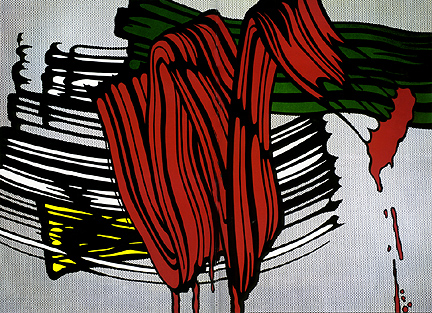Facts About Big Painting No. 6
"Big Painting No. 6" created in 1965 by Roy Lichtenstein, is an impressive oil and Magna on canvas piece measuring 235 cm by 330 cm. This artwork is part of Lichtenstein's renowned Brushstrokes series, which highlights the use of a house-painter's brush in its execution. This series offers a satirical commentary on Abstract Expressionism by showcasing mechanical reproduction through painterly techniques.
In 1970, "Big Painting No. 6" garnered significant attention when it sold for $75,000, setting a new auction price record for a living American artist at the time and surpassing Andy Warhol’s previous record. Today, the painting resides in the Kunstsammlung Nordrhein-Westfalen collection.
The artwork features a dynamic background of Ben-Day dots, overlaid with bold brushstrokes in white, yellow, green, and red. These brushstrokes mimic the style of Abstract Expressionism but are meticulously crafted to appear as though mechanically produced. This blend of technique and satire is central to the piece's allure, as Lichtenstein playfully critiques the spontaneity of action painting.
Critics have lauded "Big Painting No. 6" for transforming a seemingly mundane task into a captivating artistic endeavor. Lichtenstein's subtle humor shines through as he parodies the intense, emotional brushwork typical of Abstract Expressionism. His unique approach involves creating the illusion of mass production, thereby revitalizing the genre with a fresh perspective.
The painting's striking composition, characterized by its lack of shading and bold outlines, contributes to its powerful visual impact. Lichtenstein's quasi-mechanical rendering of spontaneous brushstrokes has been celebrated for its innovative commentary on art and mass production.

 Denmark
Denmark